Create successful ePaper yourself
Turn your PDF publications into a flip-book with our unique Google optimized e-Paper software.
ORAL PRESENTATIONS<br />
17<br />
Free Paper Session: Infection<br />
THE IRRESISTIBLE FORCE OF LONG FIBRE ACTIVATED CARBON CLOTH ON<br />
COLONISED WOUND OUTCOMES<br />
Martin Tadej 1 , Cathie Bree-Aslan 1 , Sylvie Hampton 1 , Aaron Knowles 1<br />
1 Wound Healing Centres CIC (Eastbourne, United Kingdom).<br />
Aim: To ascertain the antimicrobial and overall performance of Long Fibre Carbon dressing on<br />
2 cohorts of patients with non-healing colonised wounds.<br />
Methods:<br />
• Subjects were treated for 4 weeks using Long Fibre Carbon dressing<br />
• Swabs were taken from all wounds on days 1, 3 and 7<br />
• pH was tested on each visit<br />
• Photographs were obtained on each visit.<br />
• Subjects seen twice a week initially until 7th day; visits were then weekly<br />
• Lined buckets of tap water were used for leg cleansing<br />
• Qualitative and quantitative data and wound progress was recorded in CRFs<br />
• Wound measurements were obtained with Digital Planimetry.<br />
Results:<br />
• Exudate level decreased at each visit for all subjects and the number of those subjects with<br />
serous exudate rose from 60% to 85%, demonstrating a reduction in bacterial loading.<br />
• 100% of cohort 2 experienced pain reduction during the first week of using the dressing. One<br />
subject expressed a mild increase of pain on day 1 of the evaluation but this returned to base<br />
level of 1 by the second visit.<br />
• Only 20% of subject yielded swabs negative for any organisms on day 7 though visually all<br />
100% of wounds showed reduced slough presence and greater formation of granulating tissue<br />
over the first week and this continued to improve. The bacteria type in the wound changed rather<br />
than reduced but this colonisation did not affect wound healing.<br />
• Clinicians found it easy to apply and remove and rating of the product was 100% that they would<br />
wish to use it again.<br />
• Malodour was significantly reduced as would be expected when bacterial load is reduced.<br />
• Pseudomonas incidence dropped from 2 subjects to 1 for days 3 and 7<br />
• Two subjects were clear of bacterial cultures on swab results by day 7<br />
• Group C Beta-haemolytic streptococcus bacteria incidences were low, one initially then 2 on day<br />
3 before no trace was found on any subjects on day 7. However, both subjects who had group C<br />
on day 3 developed group G on day 7.<br />
• Purulence was only seen in 2 subjects at the start and was eliminated by day 3 though<br />
reoccurred in one subject by the end of the week. Progression from purulent to haemoserous to<br />
more commonly encountered and healthy serous exudates indicates an improving wound bed<br />
moving towards healing.<br />
• Exudate level decreased significantly at successive visit.<br />
• Significant malodour was only encountered on the first visit before use of the long fibre carbon<br />
began with all reports falling to mild or none by day 3.<br />
Conclusions: This evaluation demonstrated some the effectiveness of Long Fibre Carbon in<br />
chronic wounds and supported the idea that colonisation can be reduced and has the possibility of<br />
changing views of how Long Fibre Carbon should be positioned in wound care.<br />
FREE PAPER SESSION: INFECTION<br />
18<br />
Free Paper Session: Infection<br />
EFFICACY OF VARIOUS TOPICAL ANTIMICROBIAL AGENTS IN DIFFERENT TIME<br />
PERIODS AFTER BACTERIAL CONTAMINATION OF BURN WOUND<br />
Marianna Hajska 1 , Livia Slobodnikova 2 , Helena Hupkova 2 , Jan Koller 1<br />
1 Teaching Department of Burns and Reconstructive Surgery, Medical Faculty of<br />
Comenius University (Bratislava, Slovakia);<br />
2 Institute of Microbiology, Medical Faculty of Comenius University (Bratislava, Slovakia).<br />
Aim: In vitro efficacy evaluation of eleven topical antimicrobial agents frequently used in<br />
our burn centre against six multidrug-resistant bacterial strains isolated from patients´<br />
burn wounds.<br />
Material and Methods: A simple and reproducible in vitro model was used to evaluate<br />
the effects of following topical antimicrobials: 1% silver sulfadiazine, 1% acetic acid,<br />
0,2% nitrofurazone, povidone iodine solution, octenidindihydrochloride solution, chloride<br />
solution, 1% acetic acid+1% silver sulfadiazine, manuka honey dressing, 2 silver<br />
impregnated dressings and 1 dressing impregnated with silver and hyaluronic acid.<br />
Different wound models were created (freshly contaminated, 4hours, 6hours and<br />
24hours from contamination). Survival of 6 bacteria – Pseudomonas aeruginosa<br />
(2strains), Staphylococcus aureus, Staphylococcus haemolyticus, Enterococcus faecalis<br />
and Escherichia coli – was evaluated 24-hours after application of the agents.<br />
Results: The efficacy against all strains in planktonic form (freshly contaminated wound<br />
model) was excellent in the majority of the tested agents. The longer was the period<br />
between contamination and application of topical antimicrobial, the higher infectivity of<br />
the agents was observed. The highest efficacy from all the antimicrobials had povidone<br />
iodine and octenidindihydrochloride.<br />
Conclusions: Topical antimicrobial agents play an important role in treatment of burns,<br />
but they should be used according to their efficacy against bacterial strains in patients’<br />
wounds. According to the results obtained 24 hours after bacterial contamination of the<br />
burn wounds, it was not possible to kill the bacteria using topical antimicrobial therapy<br />
only.<br />
28






